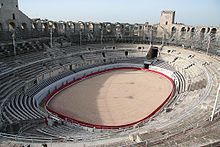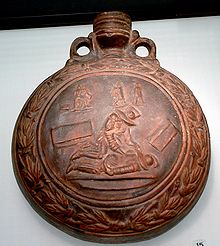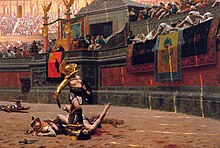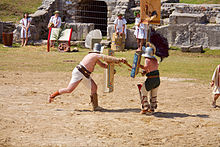Surviving contemporary accounts of games and gladiatorial matches were written by members of Rome's elite to illustrate a point or to celebrate the exceptional.
They provide very little substance for accurate reconstruction or generalisation but an outline of games can be conjectured, using written histories, contemporary accounts, statuary, ephemera, memorabilia and stylised pictographic evidence. Almost all comes from the Late Republic and Empire periods, much of it from Pompeii.
The earliest
munera took place at or near the tomb of the deceased and these were organised by their
munerator (who made the offering). Later games were held by an
editor, either identical with the
munerator or an official employed by him. As time passed these titles and meanings may have merged.
From the Principate onwards, private citizens could personally fund gladiatorial
munera with Imperial permission and the assistance of a
lanista but increasingly, the role of
editor was tied to state officialdom. From
Claudius onwards,
quaestors, the lowest rank of Roman magistrate, were obliged to personally provide two thirds of the costs of the games for their small-town communities – in effect, both an advertisement of their personal generosity and a part-purchase of their office. Bigger games were put on by senior magistrates, who could better afford them. The largest and most lavish of all were paid for by the emperor himself.
Augustan legislation – or custom – standardised the
munus as a
munus legitimum. This combined
venationes (animal fights or animal hunts) in the morning: the brief
Ludi meridiani at midday and
gladiatores in the afternoon.
Games were advertised beforehand on conspicuously displayed billboards, giving the reason for the game, its editor, venue, date and the number of paired gladiators (
ordinarii) to be used. Highlighted features were included, such as
venationes, executions, music and any luxuries to be provided for the spectators; these might include a decorated awning against the sun, and water sprinklers. Food, drink, sweets and occasionally "door prizes" could be offered. A more detailed program (
libellus) was prepared for the day of the
munus to show the names, types and match records of gladiator pairs (of interest to gamblers) and their order of appearance. Copies of the
libellus were distributed among the crowd on the day of the match.
Left-handed gladiators were advertised as an interesting rarity on
libelli; they were trained to fight right-handers, which gave them advantage over most opponents and produced an interestingly unorthodox combination.
The night before the
munus, those listed to fight were given a banquet, which was also an opportunity to order their personal and private affairs; Futrell notes its similarity to a ritualistic "last meal".
These were probably both family and public events which included even the
noxii and
damnati and they may have been used to drum up more publicity for the coming match.
The day of the
munus began with
venationes (beast hunts) and
bestiarii (beast fighting) gladiators. Sometimes beasts were unharmed and simply exhibited.
The content of
ludi meridiani was variable, but usually involved executions of
noxii (sometimes as "mythological" re-enactments) or others condemned
(damnati) to the arena.
Gladiators may have been involved in these though the crowd – and the gladiators themselves – preferred the "dignity" of an even contest.
There were also comedy fights; some may have been lethal. A crude Pompeian graffito suggests a burlesque of musicians, dressed as animals named
Ursus tibicen (flute-playing bear) and
Pullus cornicen (horn-blowing chicken), perhaps as accompaniment to clowning by
paegniarii during a "mock" contest of the
ludi meridiani.
Pompeian tomb evidence shows the
munus as a civic and religious rite sponsored by a magistrate as
editor. A procession (
pompa) entered the arena led by
lictors bearing
fasces to signify the magistrate's power over life and death. They were followed by a small band of
tubicines playing a fanfare. Images of the gods were carried in to sanctify the
pompa, followed by a scribe (to record the outcome) and a man carrying the palm branch used to honour victors. The magistrate
editor entered among a retinue who carried the arms and armour to be used; more musicians followed then horses. The gladiators presumably came in last.
"Warm-up" matches were probably fought before the main events, using blunted weapons – some
munera may have used blunted weapons throughout.
The
editor (or his honoured representative) would check the weapons (
probatio armorum) for the "real" matches.
These were the highlight of the day — as inventive, varied and novel as the
editor could afford. Armatures could be very costly – some were flamboyantly decorated with exotic feathers, jewels and precious metals. Increasingly the
munus was the
editor's gift to spectators who had come to expect the best as their due.
In late Republican
munera, between 10 and 13 pairs could have fought on one day; this assumes one match at a time in the course of an afternoon.
The Zilten mosaic in Libya (ca 80–100 CE) shows musicians playing an accompaniment to provincial games (with gladiators,
bestiarii, or
venatores and prisoners attacked by beasts). Their instruments are a long straight trumpet (
tubicen), a large curved horn (
Cornu) and a
water organ (
hydraulis).
Similar representations (musicians, gladiators and
bestiari) are found on a tomb relief in
Pompeii.
Factions and rivals
Popular factions of the
munera (and
ludi) are described throughout the Imperial era.
Under Augustan legislation, the Samnite type was renamed
secutor (equipped with an oblong or "large" shield), whose supporters were
secutarii.
As the games evolved, any lightly armed, defensive fighter could be included in this group. The heavily armoured and armed Thracian types (
Thraex) and Murmillo, who fought with smaller shields, were
parmularii (small shield), as were their supporters. Trajan preferred the
parmularii and Domitian the
secutarii; Marcus Aurelius took neither side. Nero seems to have enjoyed the brawls between rowdy, enthusiastic and sometimes violent factions, but called in the troops if they went too far.
Once a band of five retiarii in tunics, matched against the same number of secutores, yielded without a struggle; but when their death was ordered, one of them caught up his trident and slew all the victors. Caligula bewailed this in a public proclamation as a most cruel murder.
There were also local rivalries. At Pompeii's amphitheatre, trading of insults between Pompeians and
Nucerian spectators during public
ludi led to stone throwing and riot. Many were killed or wounded. Nero banned gladiator
munera (though not the games) at Pompeii for ten years as punishment. The story is told in graffiti and high quality wall painting, with much boasting of Pompeii's "victory" over Nuceria.
Amphitheatres
Most spectators would have witnessed gladiator fights in the
arenas or
amphitheatres built throughout the Republic and later, the Empire.

The
Colosseum in
Rome,
Italy. A photograph of the best known
Roman era amphitheatre taken in the early evening. Gladiatorial combats were the main event and usually held around this time of day.
Early
munera were probably private affairs, and offered limited visibility for non-privileged spectators. As these events became larger, open spaces such as the
Forum Romanum were adapted (as the Forum Boarium had been) as venues in Rome and elsewhere, with temporary, elevated seating for the patron and high status spectators. These were not truly public events:
A show of gladiators was to be exhibited before the people in the market-place, and most of the magistrates erected scaffolds round about, with an intention of letting them for advantage. Caius commanded them to take down their scaffolds, that the poor people might see the sport without paying anything. But nobody obeying these orders of his, he gathered together a body of labourers, who worked for him, and overthrew all the scaffolds the very night before the contest was to take place. So that by the next morning the market-place was cleared, and the common people had an opportunity of seeing the pastime. In this, the populace thought he had acted the part of a man; but he much disobliged the tribunes his colleagues, who regarded it as a piece of violent and presumptuous interference.
Towards the end of the Republic, Cicero (Murena 72–3) still describes these shows as ticketed — their usefulness was served by inviting the rural tribunes of the plebs, not the people of Rome
en masse - but in Imperial times, poor citizens in receipt of the
corn dole were allocated free seating, possibly by lottery.
Others had to pay.
Ticket scalpers (
Locarii) sometimes sold or let out seats at inflated prices.
Martial wrote that "Hermes [a gladiator who always drew the crowds] means riches for the ticket scalpers".
The standard amphitheatre layout made the execution of justice visible to all classes. It elevated, separated and distanced the Roman community from the place where judgment was meted out. It was a theatre, with the arena as stage, a place of entertainment and containment, its actors polluted by their association with ignominy and death. From across the stands, crowd and
editor could assess each others character and temperament, and freely express their mutual pleasure or displeasure not only at the spectacle below but at each other. For the crowd, the amphitheatre afforded unique opportunities for free expression and free speech (
theatralis licentia). Petitions could be submitted to the
editor (as magistrate) in full view of the community.
Factiones and claques could vent their spleen on each other, and occasionally on Emperors. The emperor Titus' dignified yet confident ease in his management of an amphitheatre crowd and its factions were taken as a measure of his enormous popularity and the rightness of his imperium. The amphitheatre
munus thus served the Roman community as living theatre and a court in miniature, in which judgement was also served on the judges.
Yet permanent amphitheatres appeared long after the
munera had become an established part of Roman life. The blocking of earlier provision for permanent venues — and particularly of permanent seating — reflected genuine unease, not simply at political graft but at the erosion of public morals that must arise from frequent and excessively "luxurious"
munera.
Pompeii's first amphitheatre was built by
Sullan colonists around 70 BCE.
The first in the city of Rome was the extraordinary wooden Amphitheatre of
Gaius Scribonius Curio (built 53 BCE).
The first part-stone amphitheatre in Rome was inaugurated in 29–30 BCE, in time for the triple triumph of Octavian (later Augustus).
Shortly after it burned down in 64 CE,
Vespasian began its replacement, later known as the Amphitheatrum Flavium (
Colosseum), which seated 50,000 spectators and would remain the largest in the Empire. It was
inaugurated by
Titus in 80 CE, the personal gift of the Emperor to the people of Rome, paid for by the Imperial share of booty after the Jewish Revolt.

Roman arena at
Arles, inside view
Amphitheatres also provided a potential model for social control. Seating was "disorderly and indiscriminate" until
Augustus prescribed its arrangement in his Social Reforms. To persuade the Senate, he expressed his distress on behalf of a Senator who could not find seating at a crowded games in
Puteoli:
In consequence of this the senate decreed that, whenever any public show was given anywhere, the first row of seats should be reserved for senators; and at Rome he would not allow the envoys of the free and allied nations to sit in the orchestra, since he was informed that even freedmen were sometimes appointed. He separated the soldiery from the people. He assigned special seats to the married men of the commons, to boys under age their own section and the adjoining one to their preceptors; and he decreed that no one wearing a dark cloak should sit in the middle of the house. He would not allow women to view even the gladiators except from the upper seats, though it had been the custom for men and women to sit together at such shows. Only the Vestal virgins were assigned a place to themselves, opposite the praetor's tribunal.
These arrangements do not seem to have been strongly enforced.
Death, disposal, and remembrance

A flask depicting the final phase of the fight between a
murmillo (winning) and a
thraex.
The proximity of death defined the
munus for all concerned. To die well, a gladiator should never ask for mercy, nor cry out.
A "good death" redeemed a defeated gladiator from the dishonourable weakness and passivity of defeat, and provided a noble example to those who watched:
For death, when it stands near us, gives even to inexperienced men the courage not to seek to avoid the inevitable. So the gladiator, no matter how faint-hearted he has been throughout the fight, offers his throat to his opponent and directs the wavering blade to the vital spot. (Seneca, Epistles, 30.8)
Some Mosaics show defeated gladiators kneeling in preparation for the moment of death. Seneca's "vital spot" seems to have meant the neck.
Gladiator remains from Ephesus confirm this.
In the fully developed public
munus, the death of a gladiator was followed by the ritualised removal of his body: the rites involved remain uncertain in origin, development and form. The Christian author
Tertullian, commenting on practice in Roman
Carthage, describes the removal of corpses by one who impersonates the "brother of Jove",
Dis Pater. This
arenarius strikes the corpse with a mallet and another, dressed as
Mercury, tests for life-signs with a heated "wand". Tertullian's commentary is on what appear to him as hollow impieties: in the eyes of their insincere worshippers, Rome's false deities are acceptably impersonated by low and murderous persons for the purposes of human sacrifice and evil entertainment. The victims might be
noxii or gladiators; Kyle considers the latter unlikely as Tertullian's context here is the
ludi meridiani at which most
noxii – therefore also Christian martyrs of the arena – met their deaths in demeaning theatrical farces. While the identification of Mercury with
Hermes psychopompos seems to have been well established by the peak era of the
munera, and a Mercury (or Hermes)
arenarius figure seems to have been introduced around that time, this may have been a theatrical innovation of the
ludi meridiani rather than a tradition of the gladiator
munera.
Isidore's later identification of the Etruscan demon (and possible psychopomp)
Charun as an original for a presumed amphitheatre "
Charon" (certainly a psychopomp but not reliably attested in this context) may simply offer fanciful support to his speculated Etruscan origins for the games as a whole. Some details of these exit rites are more certain: gladiators who had died well might be removed with dignity on a couch of
Libitina through the Libitinarian Gate: those who had dishonoured themselves would not only be denied the relative mercies of a quick death but having broken their vow would be treated as
noxii, dragged away as carrion, with hooks, by a Mercury figure or other attendants. Whether the corpse of such a gladiator could be redeemed from further ignominy by friends or
familia is not known: Tertullian makes no distinctions in this regard, extending his sacrificial theme with the literal offer of a fallen gladiator's blood to
Jupiter Latiaris by an officiating priest – a travesty of the offering of the blood of martyrs – but places this within a
munus (or a festival) dedicated to Jupiter Latiaris. As no such practise is otherwise recorded, Tertullian may have mistaken or reinterpreted what he saw. Modern pathological examination confirms the probably fatal use of the mallet on some (not all) gladiator skulls:
other than this, the body would have been removed to the arena morgue by attendants, in whatever guise and by whatever means, stripped of its armour and in some accounts, had its throat cut to make sure that dead was dead. Meanwhile, the arena sand would be raked for the next bout, or fresh sand strewn.
The overall death rate among gladiators is unknown, but few survived more than 10 matches or lived past the age of 30. One (Felix) is known to have lived to 45 and one retired gladiator lived on to 90. George Ville calculated an average age at death at 27 for gladiators (based on headstone evidence), with mortality "among all who entered the arena" around the 1st century CE at 19/100. A rise in the risk of death for losers, from 1/5 to 1/4 between the early and later Imperial periods, seems to suggest
missio was granted less often.
Marcus Junkelmann disputes Ville's calculation for average age at death; the majority would have received no headstone, and would have died early in their careers, at 18–25 years of age.
Death and disposal perpetuated the divisions and judgements of society. In the pre-Christian era, the highest status funerals involved expensive, prolonged cremation ceremonies, sometimes complete with a
munus offering. At the opposite extreme, the
noxii (and possibly other
damnati) could be thrown into rivers or dumped unburied.
This extended their
damnatio beyond death into perpetual oblivion and their shade (
manes) to restless wandering upon the earth as dreadful
larvae or lemures.
All others – citizens, slaves or free – were usually buried beyond the town or city limits to avoid the ritual and physical pollution of their community. Gladiators were segregated in separate cemeteries. Even for those whose death had brought honourable release, the taint of
infamia was perpetual.
Memorials were a major expense, and testify only to those who prospered. Gladiators could subscribe to a union (
collegia) which ensured proper burial, with compensation for wives and children. The gladiator's
familia or one of its members (including
lanistae, comrades, wives and children) sometimes paid.
Tomb inscriptions from the Eastern Empire include these brief examples:
"The familia set this up in memory of Saturnilos."
"For Nikepharos, son of Synetos, Lakedaimonian, and for Narcissus the secutor. Titus Flavius Satyrus set up this monument in his memory from his own money."
"For Hermes. Paitraeites with his cell-mates set this up in memory".
The hand of
Nemesis absolved a gladiator from the ignominy of defeat, and his memorial maintained his
virtus in perpetuity as a skilled fighter, worth avenging:
"I, Victor, left-handed, lie here, but my homeland was in Thessalonica. Doom killed me, not the liar Pinnas. No longer let him boast. I had a fellow gladiator, Polyneikes, who killed Pinnas and avenged me. Claudius Thallus set up this memorial from what I left behind as a legacy."









